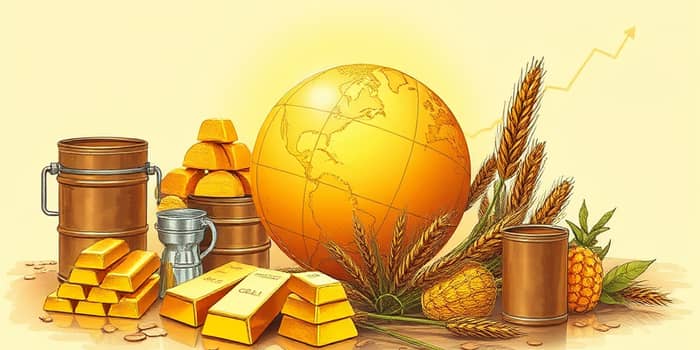
In today’s ever-evolving financial landscape, commodities have emerged as a vital component of diversified portfolios. As market volatility intensifies and inflation remains persistent, investors increasingly seek alternative assets that can deliver stability, growth, and protection against economic uncertainty.
In the wake of sharp declines in stocks and bonds during 2022, commodities demonstrated resilience by outperforming traditional asset classes. With US inflation hovering above pre-pandemic targets and geopolitical tensions persisting, many investors now recognize the importance of natural inflation hedges and tangible assets in their portfolios.
Commodities often exhibit a low or negative correlation to equities and bonds, meaning they can cushion losses when the broader market underperforms. For instance, the Bloomberg Commodity Index rose sharply in both 2008 and 2022, periods marked by elevated inflation rates and financial turbulence.
Diversification is a cornerstone of sound investment strategy. By allocating a portion of capital to commodities, investors can spread risk across asset classes and reduce their overall portfolio volatility. During market downturns, commodities may offer performance that is uncorrelated with traditional stocks and bonds, thus enhancing risk-adjusted returns over the long term.
Historical data supports this approach: gold achieved a 660% price return, while copper soared by 435% between the early 2000s and March 2025, surpassing major equity indices such as the FTSE 100. These figures underscore the potential of commodities to deliver attractive long-term returns when integrated strategically into diversified portfolios.
Commodities encompass a broad range of raw materials and agricultural products, each with unique supply-and-demand drivers. Recognizing the distinctions among commodity categories is essential for informed decision-making and effective risk management.
Investors can access commodity markets through a variety of vehicles, each offering distinct benefits and risks. Selecting the right method depends on individual goals, risk tolerance, and investment horizon.
Among these, ETFs like the iShares Gold Trust (IAU) and SPDR Gold Shares (GLD) have become popular due to their low minimum investment requirements and ease of access for retail investors.
Gold and silver occupy central roles in commodity investing. Frequently referred to as “safe haven” assets, they serve as stores of value during periods of economic stress and rising inflation.
Central banks, especially in emerging economies, have been accumulating gold reserves to diversify away from US dollar holdings. This trend, coupled with ongoing geopolitical uncertainty, drove gold to record highs in early 2025.
Silver, while sharing gold’s status as a precious metal, also enjoys significant industrial demand. Its applications in electronics, photovoltaics, and medical devices can amplify price movements during economic expansions. However, silver’s price tends to be more volatile than gold, reflecting its dual role as both a commodity and a precious metal.
Investors can access these metals through physical forms such as bars and coins, exchange-traded funds like GLD and SLV, shares of mining companies such as Barrick Gold, and actively managed mutual funds focused on precious metals.
Reviewing historical performance can illuminate the potential benefits and limitations of commodity investing. From the early 2000s through March 2025, gold appreciated by 660%, while copper surged by 435%.
Despite these strong long-term returns, commodities are prone to significant short-term fluctuations. For example, the Bloomberg Commodity Index soared by 16% in 2022 amid rising global inflation but also experienced drawdowns during periods of economic slowdown or oversupply.
Key drivers of recent performance include sustained inflation rates (CPI above 2.9%, Core CPI at 3.2% as of December 2024), geopolitical events such as the conflict in Eastern Europe, and supply constraints resulting from limited new mining projects and rising extraction costs.
Looking ahead, several macro trends will influence commodity prices and investor opportunities:
Commodity investing is not a one-size-fits-all solution, but it offers compelling benefits for those seeking diversification beyond stocks and bonds or a hedge against rising inflation.
First, assess your overall asset allocation and determine an appropriate commodity allocation that aligns with your risk profile.
Second, research individual commodities and select investment methods that match your expertise and comfort level, balancing costs, liquidity, and volatility.
Third, monitor macroeconomic indicators such as inflation, currency movements, and supply trends to time exposures effectively.
Finally, maintain a disciplined approach, recognizing that volatility is inherent in commodity markets and adopting a long-term perspective can help navigate price swings.
Ultimately, integrating commodities into a well-diversified portfolio can enhance returns, reduce risk, and provide a valuable buffer against the unpredictable forces that shape global markets. As you navigate the complexities of commodity investing, informed decision-making, rigorous analysis, and a patient outlook are your greatest allies.
References













